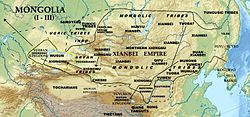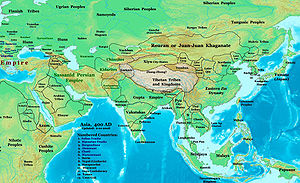Yueban
Yueban | |
|---|---|
| 160–490 | |
 | |
| Historical era | 1st millennium |
• Established | 160 |
• Disestablished | 490 |
| Today part of | Kazakhstan |
Yueban (Chinese: 悅般) (Middle Chinese: */jiuᴇt̚-pˠan/ < Late Han Chinese: */jyat-pɑn/[1]), colloquially: "Weak Xiongnu", was the name used by Chinese historians for remnants of the Northern Xiongnu[2] in Zhetysu, now part of modern-day Kazakhstan. In Chinese literature they are commonly called Yueban. The Yuebans gained their own visibility after disintegration of the Northern Xiongnu state, because unlike the main body of the Northern Xiongnu, who escaped from the Chinese sphere of knowledge, the Yueban tribes remained closer to China.
The Yueban emerged after the disintegration of the Xiongnu confederation. They underwent a strong influence of the Sogdian culture.[3] About 480s, the Yueban split into four Chuy tribes:[4] Chuyue (處月), Chumi (處密), Chumukun (處木昆), and Chuban (處半).
One Yueban branch, Chuyue, later intermixing with Göktürks, formed the Shatuo of the Western Göktürk Khaganate.[5] The Yueban-descended Shatuo played an important role in Chinese dynastic history. In the 10th century the remaining Shatuo branch of the Chuy tribe possibly joined Mongolic-speaking Tatar confederation in the territory of the modern Mongolia, and became known as Ongud or White Tatars[6][7] branch of the Tatars.
Another Yueban-descended tribe, Chumukun, might be associated with the Kimek confederation.
Identity and Location[]
Yury Zuev reconstructed 悅般 Yueban's underlying form as *Örpen ~ Ürpen, identifiable with the toponym Örpün mentioned in Bilge Khagan inscription.[8][9] Zuev also compared *Örpen ~ Ürpen to the prefecture 咽麫 Yànmiàn (supposedly from MC < *iet-mien < *ermen ~ örmen?) at the Irtysh headwaters in the 7th century. Meanwhile, Vladimir Tishin compared 咽麫 Yànmiàn (< LMC *ʔjianˊ-mjianˋ < EMC *ʔɛnH-mjianH < *Emän) to the names of the Chumukun's "town of Yan" (咽城) and the Emel River.[10]
Gumilyov further identified Yueban with the Altï Čub Soğdak "Six Prefectures' Sogdians".[11] Meanwhile, Sergey Klyashtorny identified the Altï Čub Soğdak with the Sogdian-populated "Six Barbarian Prefectures" (六胡州 Liùhúzhōu)[12] of Lu 魯, Li 麗, Han 含 (or She 舍), Sai 塞, Yi 依, and Qi 契, established by Tang Chinese in 679[13] from "surrendered Turks" (降突厥),[14] "originally a Sogdian people who had submitted collectively to the Eastern Turks"[15] Later on, Altï Čub Soğdak were mentioned in Kul Tegin inscription as enemies of the Second Turkic Khaganate,[16] and they were conquered by Bilge Khagan in 701. The Six Prefectures also revolted against Tang, until Tang army dispersed them in 722.[17]
Language and customs[]
According to the Book of Wei, the Yuebans' language and customs were the same as the Gaoche, who were Turkic speakers. Yuebans cut their hair and trimmed their ghee-smeared, sun-dried, glossy eyebrows evenly, and washed before meals three times every day.[18][19]
History[]


Between 155 and 166, the Xianbei (*Särpi) (Ch. 鮮卑, Wade–Giles Hsien-pi, Hsien-pei), a former vassal tribe of the Xiongnu, united under Tanshihuai conducted a series of campaigns against Northern Xiongnu, eventually defeating them and forcing them to flee west, which started a series of Xiongnu migrations (93 CE - circa 380 CE) westward to southern Siberia and Central Asia.[20][21]
The defeat ended the prominence of the Xiongnu as a major power in inner Asia. Tanshihuai expelled the Xiongnu from Dzungaria to beyond the Tarbagatai Mountains, and pushed the Dingling beyond the Sayan Mountains. The defeat had cost the Xiongnu their revenue from the Silk Road in the agricultural dependencies in the Tarim Basin ("Western Territories", Xiyu or Xinjian of the Chinese annals), forcing them to find new dependencies, and the Xiongnu split again.
Tribes known as the "Weak Xiongnu"[22] or Yueban took advantage of the vulnerability of the neighboring Uar (a people possibly linked to the Hephthalites and/or the "Avars" who later invaded Eastern Europe) and conquered Zhetysu, where they established the principality of Yueban. Later, some Uar returned to Zhetysu, and in cooperation with the Mukrins, a Xianbei tribe, occupied the Tianshan slopes in the 2nd century, retaining their independence for some time as the Western Xianbei Horde.[23]
Zhetysu was also populated by the Azi (who lived between Suyab and Uzkent) and the Tuhsi. The Azi and Tuhsi are sometimes linked to Asii[a][24][25] and Tukharas;[26] Indo-European peoples who had conquered Bactria six centuries earlier, and formed the Kushan Empire. According to Persian historian Gardizi, Azi and Tuhsi were remnants of Türgesh,[27][28] along with Khalaj.[29] Karakhanid linguist Mahmud Kashgari described Tuhsi as a dynastic tribe of Turkic-speaking monoglots.[30] This may suggest that Indo-European peoples underwent language replacement, in the form of "Turkification", had occurred. The Azi were also alternatively proposed to be Yeniseian-speaking, as Vasily Bartold noted the similarities between Old Turkic